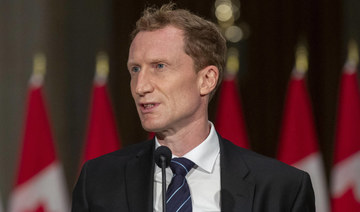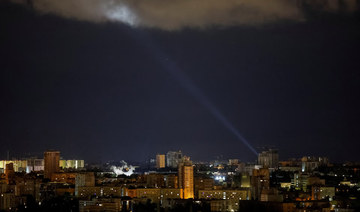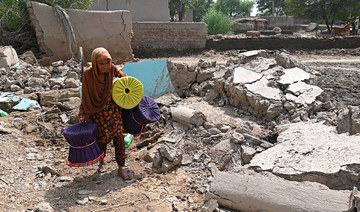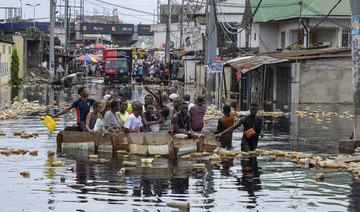NEW DELHI: As Hindu devotees prepare to inaugurate a grand temple to one of their holiest deities, India’s minority Muslims plan to begin building a new mosque in the same city later this year, hoping to make a fresh start after a bloody, decades-long dispute.
Hajji Arfat Shaikh, the head of the development committee of the Indo-Islamic Cultural Foundation (IICF) that is overseeing the mosque project, said this week that construction would begin in May, after the holy month of Ramadan, and the mosque would take three to four years to build.
Hindu zealots razed a 16th century mosque in the northern Indian city of Ayodhya in 1992, saying that it was built over an ancient temple on the site that marked the birthplace of Hindu god-king Ram.
The dispute had scarred relations between the communities for decades and the destruction of the mosque sparked nationwide riots that killed 2,000 people, mostly Muslims.
India’s top court said in 2019 that the razing of the mosque was unlawful, but ruled that evidence showed there was a non-Islamic structure beneath it. It ordered that the site be given to Hindu groups to build a temple and Muslim community leaders be given land elsewhere in the city for constructing a mosque.
While construction of the $180 million temple began within months and the first phase is set to open on Monday, Muslim groups have struggled to raise funds and begin work at a desolate site about 25 km (15 miles) away.
“We hadn’t approached anyone ... there was no public movement for it (funds),” said Zufar Ahmad Faruqi, the president of the IICF. Hindu groups aligned with Prime Minister Narendra Modi’s Bharatiya Janata Party (BJP) began seeking donations more than three decades back and have collected more than 30 billion rupees ($360 million) from 40 million people in India.
The mosque project was delayed also because it had to be redrawn to add more traditional elements in the structure, like minarets, said Athar Hussain, a secretary at the IICF. A 500-bed hospital has also been planned in the complex.
A crowd-funding website is expected to be launched in the coming weeks, said Shaikh, who is also a BJP leader.
The mosque has been named “Masjid Muhammed bin Abdullah” after Prophet Muhammad, moving away from “Babri Masjid” or mosque as the disputed structure was called, after the emperor Babur who established the Mughal empire.
“Our effort has been to end and convert enmity, hatred among people into love for each other...irrespective of whether or not you accept the Supreme Court judgment,” said Shaikh. “All this fighting will stop if we teach good things to our children and people.” ($1 = 83.0550 Indian rupees)
New mosque construction in India’s Ayodhya to begin in May, Muslim group says
https://arab.news/rm8fg
New mosque construction in India’s Ayodhya to begin in May, Muslim group says
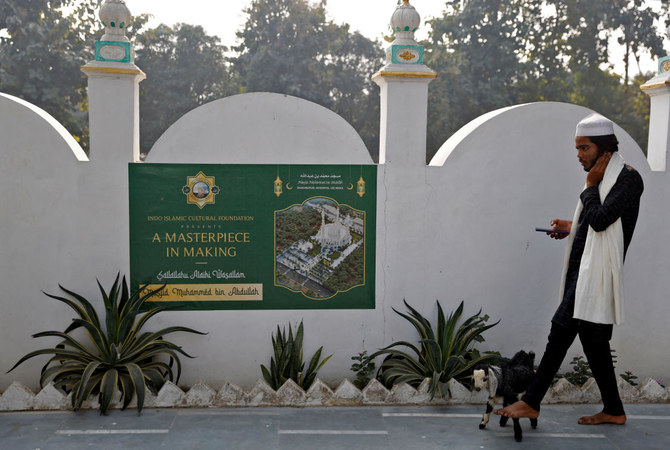
Hundreds evacuated from Ukraine border after Russian offensive

- Russian forces make small advances in the area it was pushed back from nearly two years ago
- The Kharkiv region has been mostly under Ukrainian control since September 2022
KYIV: Hundreds of people were evacuated from areas near the Russian border in Ukraine’s Kharkiv region, the regional governor said Saturday, a day after Moscow launched a surprise ground offensive.
Russian forces made small advances in the area it was pushed back from nearly two years ago, the latest in a series of gains as Ukrainian forces find themselves outgunned and outmanned.
“A total of 1,775 people have been evacuated,” Kharkiv governor Oleg Synegubov wrote on social media.
He reported Russian artillery and mortar attacks on 30 settlements over the past 24 hours.
Ukrainian President Volodymyr Zelensky said a “fierce battle” was under way in Kharkiv.
“We must disrupt Russian offensive operations and return the initiative to Ukraine,” Zelensky said on Saturday.

The Kharkiv region has been mostly under Ukrainian control since September 2022.
A senior Ukrainian military source said Russian forces had advanced one kilometer (0.6 miles) into Ukraine and were trying to “create a buffer zone” in the Kharkiv and neighboring Sumy regions to prevent attacks on Russian territory.
Ukrainian forces have multiplied attacks inside Russia and Russian-held areas of Ukraine, particularly on energy infrastructure.
On Saturday, Moscow-installed authorities in the Russian-occupied Lugansk region in eastern Ukraine said three people were killed by a Ukrainian strike with US-made missiles on an oil depot.
Governor Leonid Pasechnik said the strike “enveloped the oil depot in fire and damaged surrounding homes.”
“The death toll has risen to three and eight more people are in hospital,” he said on social media.
Officials in Kyiv had warned for weeks that Moscow might try to attack its northeastern border regions, pressing its advantage as Ukraine struggles with delays in Western aid and manpower shortages.
Ukraine’s military said it had deployed more troops and Zelensky said Ukrainian forces were using artillery and drones to thwart the Russian advance.
“Reserve units have been deployed to strengthen the defense in this area of the front,” it said.
The US-based Institute for the Study of War said on Friday that Russia had made “tactically significant gains.”
But the main aim of the operation was “drawing Ukrainian manpower and materiel from other critical sectors of the front in eastern Ukraine,” it said.
ISW said it did not appear to be “a large-scale sweeping offensive operation to envelop, encircle and seize Kharkiv” — Ukraine’s second biggest city.
Washington announced a new $400 million military aid package for Kyiv hours after the offensive began, and said it was confident Ukraine could repel any fresh Russian campaign.
Heavy rains set off flash floods in northern Afghanistan, killing at least 200 people: UN report says

ISLAMABAD: Flash floods from seasonal rains in Baghlan province in northern Afghanistan killed at least 200 people on Friday, UN report said.
The floods also caused losses to homes and property in several districts, according to Edayatullah Hamdard, the provincial director of Natural Disaster Management in Baghlan. He said that the death toll was preliminary and that it “might rise as many people are missing.”
The flash floods also hit the capital, Kabul, said Abdullah Janan Saiq, the Taliban’s spokesman for the State Ministry for Natural Disaster Management. He said that rescue teams bringing food and other aid have been dispatched to the affected areas.
Saiq said that the rescue operation is the main focus of authorities at the moment, and that he later might be able to provide more precise figures on casualties and damage.
Emergency personnel were “searching for any possible victims under the mud and rubble, with the help of security forces from the national army and police,” Hamdard said earlier.
Dozens of tents, blankets and food were provided to those who lost their homes, he added.
Video footage seen on social media showed huge torrents of muddy water swamping roads and bodies shrouded in white and black cloth.
In one video clip, children are heard crying and a group of men are looking at floodwaters, in which bits of broken wood and debris from homes can be seen.
Since mid-April, flash flooding and other floods have left about 100 people dead in 10 of Afghanistan’s provinces, with no region entirely spared, according to authorities.
Farmland has been swamped in a country where 80 percent of the more than 40 million people depend on agriculture to survive.
Rains on Friday also caused heavy damages in northeastern Badakhshan province and central Ghor province, officials said.
Taliban government spokesman Zabihullah Mujahid said authorities would provide support to those impacted by the flooding across the country.
The government “expresses its deep sympathy with the families of dead and wounded, and instructs the ministry of natural disaster management, ministries of defense and interior, and provincial authorities to spare no resource in rescue efforts,” he said in a statement on X, formerly Twitter.
Mohammad Akram Akbari, the provincial director of natural disaster management in Badakhshan, said the mountainous province had seen “heavy financial losses in several areas... due to floods.”
He added that casualties were feared in Tishkan district, where flooding had blocked a road and cut off access to an area where some 20,000 people lived.
Afghanistan — which had a relatively dry winter, making it more difficult for the soil to absorb rainfall — is highly vulnerable to climate change.
In April, at least 70 people died from heavy rains and flash flooding in the country. About 2,000 homes, three mosques, and four schools were damaged last month. Thousands of people require humanitarian assistance. The flooding also damaged agriculture land and 2,500 animals died in the deluges, according to Saiq.
The nation, ravaged by four decades of war, is one of the poorest in the world and, according to scientists, one of the worst prepared to face the consequences of global warming.
Afghanistan, which is responsible for only 0.06 percent of the world’s greenhouse gas emissions, ranks sixth on the list of countries most at risk from climate change, experts say.
Half of Afghanistan’s population lives under the poverty line, and 15 million people are experiencing food insecurity, according to the World Bank.
Police arrest dozens as they break up pro-Palestinian protests at several US universities

- Israel has killed more than 34,700 Palestinians, according to Gaza’s Health Ministry
- Nearly 2,900 people have been arrested at 57 colleges and universities
NEW YORK: Police made dozens of arrests as pro-Palestinian protest encampments were dismantled Friday at the University of Pennsylvania and the Massachusetts Institute of Technology, hours after police tear-gassed demonstrators and took down a similar camp at the University of Arizona.
Philadelphia and campus police at Penn took action around daybreak to remove protesters from an encampment in place for more than two weeks. School officials said protesters were given warnings and the chance to leave without being detained. About 33 people, including faculty members and seven students, were among those arrested and charged with trespass, the school said.
Protest camps have sprung up across the US and in Europe in recent weeks as students demand their universities stop doing business with Israel or companies that support its war efforts. Organizers seek to amplify calls to end Israel’s war against Hamas in Gaza, which they describe as a genocide against the Palestinians. The top United Nations court has concluded there is a “plausible risk of genocide” in Gaza — a charge Israel strongly denies.
In Cambridge, Massachusetts, police in riot gear arrived at MIT around 4 a.m., encircled the camp and gave protesters about 15 minutes to leave. Ten students who remained were arrested, the university’s president said. A crowd outside the camp began chanting pro-Palestinian slogans but was quickly dispersed.
At the University of Arizona in Tucson, campus police in riot gear fired tear gas at protesters late Thursday — the day before the school’s main commencement ceremony — before tearing down an encampment that included wood and plastic barriers. The school said police vehicles were spiked, and rocks and water bottles were thrown at officers and university staff. Two people were arrested, a university spokesperson said. Friday night’s commencement will go forward, university President Robert Robbins said.
And at New Mexico State University in Las Cruces, police arrested 13 people Thursday night after they refused to leave a damaged and vandalized building. The charges ranged from misdemeanor trespass to felonies including battery on a peace officer, school spokesperson Amanda Bradford said. The building, Hadley Hall, was cleared and open Friday.
Protesters at the University of Wisconsin-Madison agreed Friday to permanently dismantle their 2-week-old encampment and not disrupt graduation ceremonies this weekend, in return for the opportunity to connect with “decision-makers” who control university investments by July 1. The university agreed to increase support for scholars and students affected by wars in Gaza and Ukraine.
Graduates from Pomona College in Southern California will have to travel 40 miles (65 km) for their commencement ceremony Sunday, as administrators seek to avoid a current encampment. The college said it will provide transportation to the venue, a historic theater in Los Angeles. In April, protesters entered an administration building and police arrested 20 people.
The protest movement began nearly three weeks ago at Columbia University in New York City. Some colleges nationwide cracked down immediately, while others tolerated the demonstrations. Some recently started calling in the police, citing concerns about disruptions to campus life and safety.
The Associated Press has recorded at least 75 instances since April 18 in which arrests were made at US campus protests. Nearly 2,900 people have been arrested at 57 colleges and universities. The figures are based on AP reporting and statements from schools and law enforcement agencies.
Arizona State University on Friday confirmed that it had placed its campus police chief on paid administrative leave pending a review of “complaints filed related to his actions” two weeks ago when an encampment was removed and police made more than 70 arrests during a pro-Palestine rally on the campus in Tempe.
The school said it was reviewing actions surrounding the establishment and removal of the encampment. Local news outlets reported earlier that ASU Police Chief Michael Thompson had been placed on leave after he had been seen out of uniform cutting and removing tents during the protest. The school told ABC15 Arizona earlier he had left a meeting to respond to the rally.
Although their encampment was cleared after two weeks, demonstrators at George Washington University vowed Friday to keep up their protest campaign.
Police arrested 33 people on Wednesday while ousting the initial encampment. The next night, a crowd of chanting demonstrators returned to the university about five blocks from the White House, setting up tents while a large Metropolitan Police Department force assembled. After multiple warnings to disperse, protests leaders ended the demonstration around midnight. One person was arrested for throwing water at a police officer.
The move at MIT came several days after police first attempted to clear the camp, only to see protesters storm past barriers and restore the encampment, which includes about a dozen tents in the heart of the campus in Cambridge.
Before removing the encampment, MIT earlier in the week started suspending dozens of students, meaning they’re barred from academic activities or commencement.
Protesters insist they will keep demanding MIT cut all ties to the Israeli military. The encampment was up for weeks and especially angered Jewish students, who held counterprotests nearby.
“This is only going to make us stronger. They can’t arrest the movement,” said Quinn Perian, an undergraduate student and organizer for MIT Jews for Ceasefire. “MIT would rather arrest and suspend some students than they would end their complicity with the genocide going in Gaza.”
MIT President Sally Kornbluth, in a letter confirming Friday’s arrests, wrote that her responsibility is “to make sure that the campus is physically safe and functioning for everyone ... and that everyone feels free to express their views.” The encampment, she wrote, “increasingly made it impossible to meet all these obligations.”
South Africa again requests emergency measures from world court to restrain Israel’s actions in Gaza
South Africa again requests emergency measures from world court to restrain Israel’s actions in Gaza

- The North African country joins Nicaragua and Colombia, which have filed their own requests to take part in the proceedings
- Israel has killed more than 34,700 Palestinians in Gaza, mostly women and children, according to the health ministry in the Hamas-run territory
THE HAGUE, Netherlands: South Africa urged the United Nations’ top court Friday to issue more emergency measures to restrain Israel, saying its military incursion in Rafah threatens the “very survival of Palestinians in Gaza.”
The request marks the fourth for additional measures by South Africa, which filed a genocide case against Israel late last year at the International Court of Justice. According to the latest request, the previous preliminary orders by The Hague-based court were not sufficient to address “a brutal military attack on the sole remaining refuge for the people of Gaza.”
At hearings in January, lawyers for Israel argued that its war in Gaza was a legitimate defense of its people and that it was Hamas militants who were guilty of genocide.
South Africa has asked the court to order Israel to withdraw from Rafah; to take measures to ensure unimpeded access to UN officials, humanitarian organizations and journalists to the Gaza Strip; and to report back within one week as to how it is meeting these demands.
Earlier this week, Israel issued a warning to evacuate an area of eastern Rafah where approximately 100,000 Palestinians have been sheltering. Israeli military forces have now seized the nearby border crossing with Egypt, leaving all entries and exits from the beleaguered enclave under Israeli control.
South Africa also accused Israel of violating the previous provisional measures imposed by the court. In January, judges ordered Israel to do all it could to prevent death, destruction and any acts of genocide in Gaza. Two months later, the court issued a second set of measures, telling Israel to improve the humanitarian situation, including opening more land crossings to allow food, water, fuel and other supplies.
The court also announced on Friday that Libya had asked to join the case and intervene in support of South Africa. The North African country joins Nicaragua and Colombia, which have filed their own requests to take part in the proceedings.
Separately, Nicaragua brought a complaint against Germany, arguing the European country is enabling genocide by sending arms and other support to Israel. Earlier this month, the court rejected a request for emergency measures against Berlin, but the case will continue on merits.
The war began with a Hamas attack on southern Israel on Oct. 7 in which Palestinian militants killed around 1,200 people and took about 250 hostages. The attack sparked an Israeli invasion the Gaza Strip, home to 2.3 million people.
Israel’s bombardment and ground offensives in Gaza have killed more than 34,800 Palestinians, mostly women and children, according to the Gaza Health Ministry, which does not distinguish between civilians and combatants in its figures. Much of Gaza has been destroyed and some 80 percent of Gaza’s population has been driven from their homes.
The UN says northern Gaza is already in a state of “full-blown famine.”
Strong solar storm hits Earth, could disrupt communications and produce northern lights in US

CAPE CANAVERAL, Florida: An unusually strong solar storm hitting Earth could produce northern lights in the US this weekend and potentially disrupt power and communications.
The National Oceanic and Atmospheric Administration issued a rare severe geomagnetic storm warning when a solar outburst reached Earth on Friday afternoon, hours sooner than anticipated. The effects were due to last through the weekend and possibly into next week.
NOAA alerted operators of power plants and spacecraft in orbit to take precautions, as well as the Federal Emergency Management Agency.
“For most people here on planet Earth, they won’t have to do anything,” said Rob Steenburgh, a scientist with NOAA’s Space Weather Prediction Center.
The storm could produce northern lights as far south in the US as Alabama and Northern California, according to NOAA. But it was hard to predict and experts stressed it would not be the dramatic curtains of color normally associated with the northern lights, but more like splashes of greenish hues.
“That’s really the gift from space weather — the aurora,” said Steenburgh. He and his colleagues said the best aurora views may come from phone cameras, which are better at capturing light than the naked eye.
Snap a picture of the sky and “there might be actually a nice little treat there for you,” said Mike Bettwy, operations chief for the prediction center.
The most intense solar storm in recorded history, in 1859, prompted auroras in central America and possibly even Hawaii. “We are not anticipating that” but it could come close, said NOAA space weather forecaster Shawn Dahl.
This storm — ranked 4 on a scale of 1 to 5 — poses a risk for high-voltage transmission lines for power grids, not the electrical lines ordinarily found in people’s homes, Dahl told reporters. Satellites also could be affected, which in turn could disrupt navigation and communication services here on Earth.
An extreme geomagnetic storm in 2003, for example, took out power in Sweden and damaged power transformers in South Africa.
Even when the storm is over, signals between GPS satellites and ground receivers could be scrambled or lost, according to NOAA. But there are so many navigation satellites that any outages should not last long, Steenburgh noted.
The sun has produced strong solar flares since Wednesday, resulting in at least seven outbursts of plasma. Each eruption — known as a coronal mass ejection — can contain billions of tons of plasma and magnetic field from the sun’s outer atmosphere, or corona.
The flares seem to be associated with a sunspot that’s 16 times the diameter of Earth, according to NOAA. It’s all part of the solar activity that’s ramping up as the sun approaches the peak of its 11-year cycle.
NASA said the storm posed no serious threat to the seven astronauts aboard the International Space Station. The biggest concern is the increased radiation levels, and the crew could move to a better shielded part of the station if necessary, according to Steenburgh.
Increased radiation also could threaten some of NASA’s science satellites. Extremely sensitive instruments will be turned off, if necessary, to avoid damage, said Antti Pulkkinen, director of the space agency’s heliophysics science division.
Several sun-focused spacecraft are monitoring all the action.
“This is exactly the kinds of things we want to observe,” Pulkkinen said.




